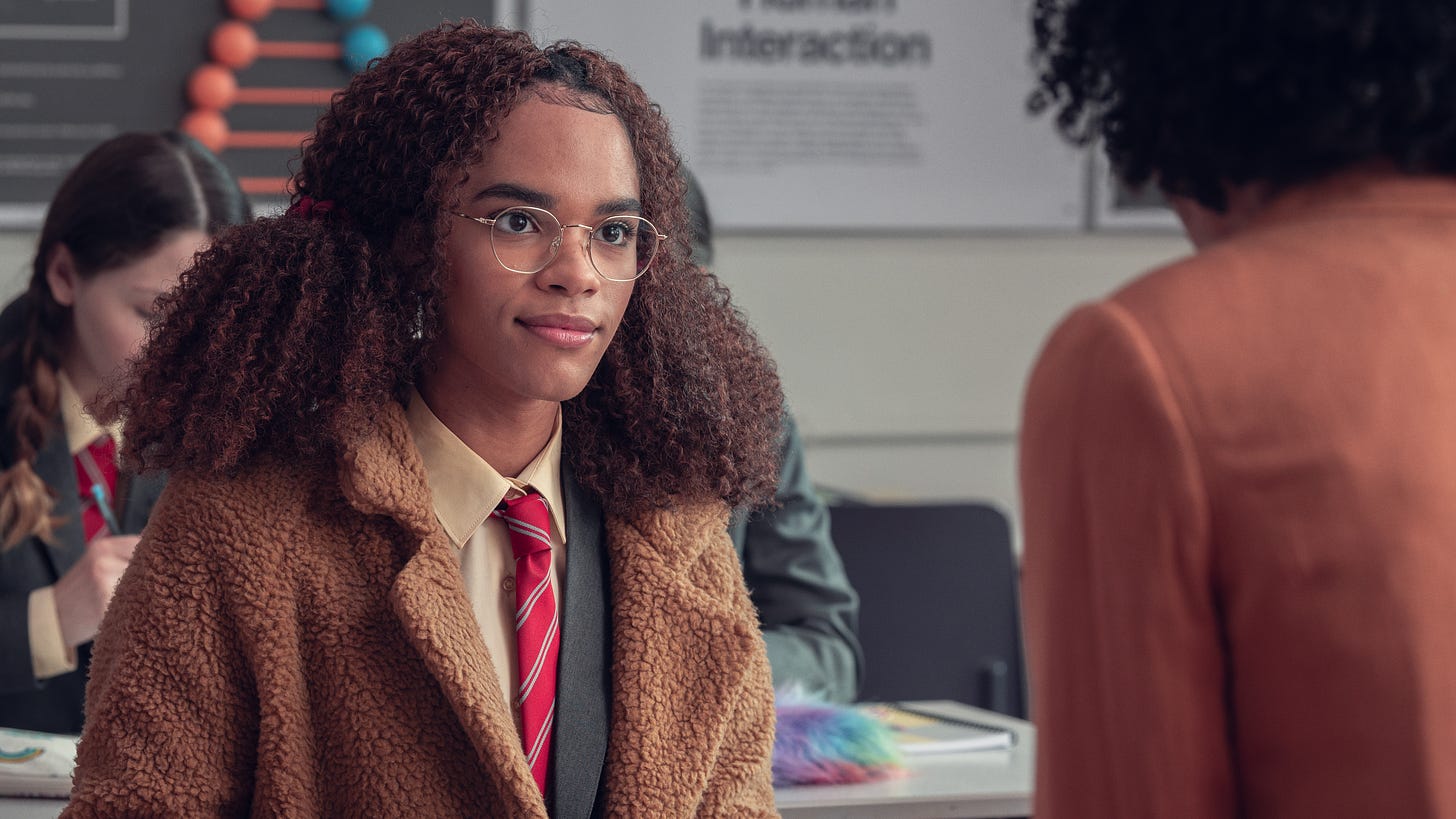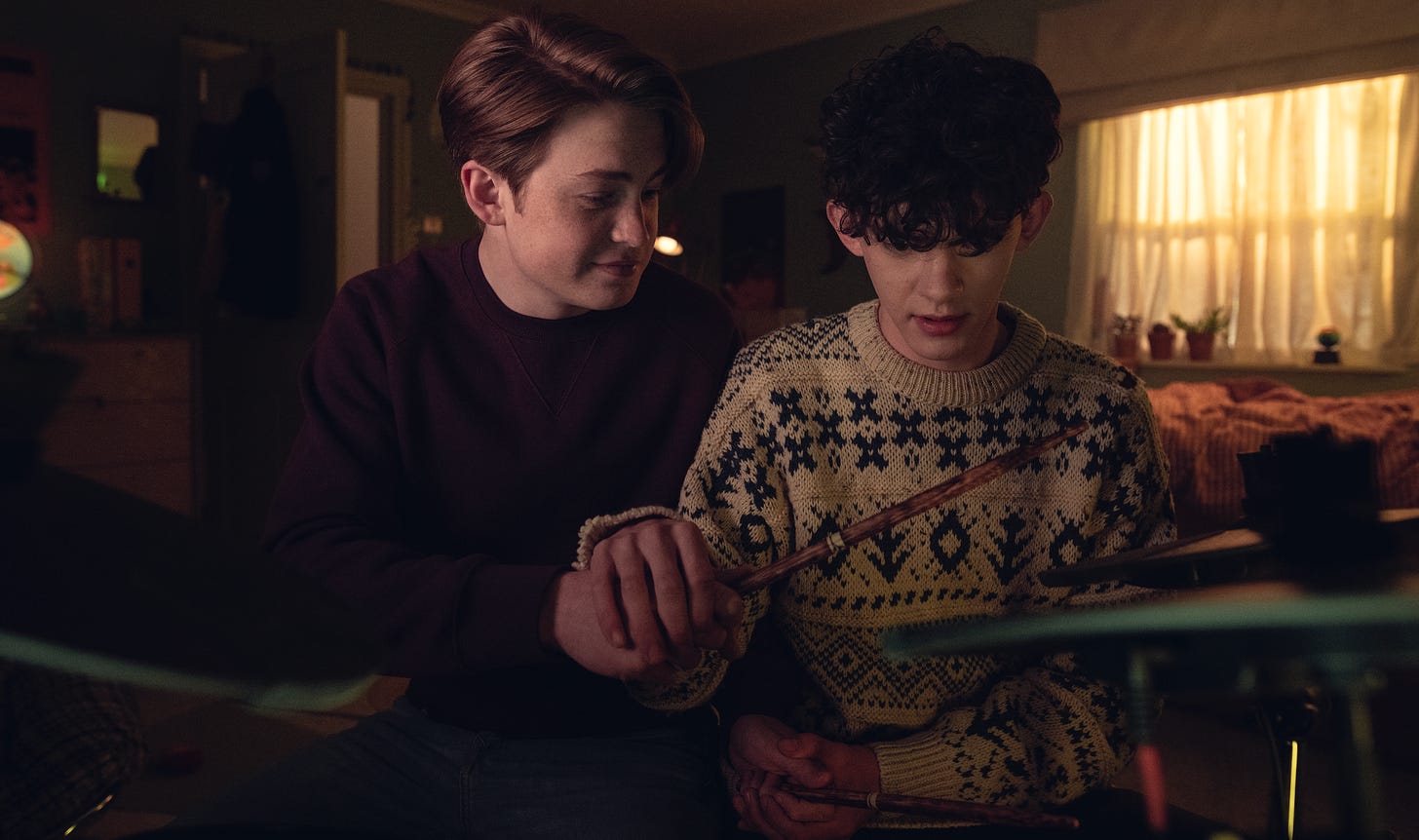Review: Heartstopper, "Crush" | Season 1, Episode 2
It's just (aah) a little crush (crush) at first, but a Snow Day makes everyone realize it might be something more
In the books, Elle’s integration into Higgs happens “offscreen”: we don’t meet her until Charlie’s birthday party in Volume 2, and while they talk about her having formerly been at Truham the books gloss over that period of her life.
It’s an interesting moment to explore, although the show is still approaching it with a lot of subtlety. Elle’s struggle to make friends isn’t just her being anti-social, or leftover trauma from her experience at Truham. It’s also inherently about the challenge of socializing within the context of gender norms. As she observes Tara and Darcy and the rest of the girls, she’s observing rituals that she may connect with emotionally, but which she was socialized to see as being not “for her” for her entire life.
The show never explicitly says this, but it makes sense that she wouldn’t be verbalizing this to anyone, especially since she’s lying to her friends about being the cool, mysterious new girl everyone wants to hang out with. In the end, it takes a dropped pencil case, a lunch invite, and the realization that Tara and Darcy share a connection to the LGBTQ+ community for Elle to accept that maybe she might be able to find her people at Higgs. She might know who she is, but how she fits into the world around her is far more complicated than anyone who isn’t trans can really understand.
“Crush” is ultimately the story of Nick Nelson realizing that maybe he doesn’t actually understand who he is, after all. Much to Charlie’s chagrin, Nick fails to correct him when he refers to him as his “supportive straight friend,” but Charlie isn’t seeing the other side of that conversation like we are. We see Nick’s initial struggle over how to reach out to Charlie, his anxiety when Charlie stops replying, and then his decision to push forward to learn more about the situation with Ben. We see his joy at Charlie’s silly Instagram photos, and his guilt at the ones that hint at the bullying he was a bystander for the year before. We know, even before Nick, that the way his friendship with Charlie is manifesting is not the same as what he has with his rugby lads.
After the premiere stays anchored in Charlie’s side of their connection, we spend more time with Nick here, although the framing still makes sure we’re with Charlie in his moments of anxiety—checking the hair in the mirror before he heads over to Nick’s, hesitating to ring the bell—lest we lose our ability to understand his own perspective. But the balance starts to shift during their “Snow Day” together. Nick doesn’t think twice about inviting Charlie over to his as he’s showing him photos of Nellie, and he enjoys their time playing video games, horsing around after Charlie smokes him at Mario Kart, and then playing in the snow with Nellie without any of the hesitation Charlie had at the front door. But the second his mother points out that he’s “more himself” around Charlie, it’s like a switch flips: what does that even mean?
After mostly building a connection between Charlie and Nick through “micro affections” in the premiere, “Crush” is the full court press, with Euros Lyn’s direction firing on all cylinders to make us believe in romance as Isaac wants to. The sunlit snowball fight is the apex of this particular effort, and it’s no coincidence that after starting to feel the sparks during his time at Charlie’s, Nick flips through the photos from that day. Reflecting on that frolic in the snow unlocks something in Nick that he had never really considered, which runs deeper than the question he types into his browser to bring the episode to a close. It’s not as simple as whether or not he’s gay: it’s a question of who the version of him in the photo with his rugby lads has been for all these years.
The “Snow Day'' and the followup at Charlie’s house are both almost moment-for-moment adapted from Oseman’s books, but it’s notable that the show introduces a fair amount of extra story between them. In that case, we jump right from Nick’s mother observations to him flipping through the photos, and then immediately jump to Nick’s visit to Charlie’s house with nothing in between. Here, though, we see Nick messaging Charlie while in the presence of the rugby lads, hiding his phone from a girl (Imogen) while cracking “Your Mom” jokes and dodging bro talk about who he’s texting. Charlie, meanwhile, is being warned off by Tao, who introduces the idea Nick is in love with Tara Jones.
The Tara Jones detail exists in the book, but it doesn’t come until after Nick asks Google his question (and we don’t learn Tara is a lesbian until later, since Elle doesn’t exist yet in the books to suss it out for us). Imogen is entirely new, though, and there’s no similar scene from Nick’s point-of-view during this period. It makes the meetup at Charlie’s particularly critical: Charlie’s choice to ask Nick around is him pushing through the doubts Tao is creating to assert what he’s feeling, while Nick’s decision to hug Charlie feels like him not just embracing a feeling he doesn’t understand, but specifically fighting through the social pressures still omnipresent in his life.
What makes Heartstopper’s story work so well is how it shifts the balance of power between Charlie and Nick at different intervals, and “Crush” captures that beautifully. Charlie is never fully confident in this relationship: he’s still in the art room asking Mr. Ajai how to get over a straight guy, and he spirals when he learns about Tara and doesn’t fully get his hopes up after the ten-second hug until Elle confirms that Nick’s alleged crush on Tara is not going to be returned. But by showing us more of Nick’s perspective, and bringing to life Oseman’s inset closeups in their interactions together, “Crush” creates a bashful ballet of complex feeling, which may or may not find clarity in the Google results Nick’s about to start sifting through.
Stray (Adaptation) Observations
As one of the (very few) people who got very mad on the internet when Love, Simon miscast his dog Bieber as a yappy little thing instead of a golden retriever, I was relieved to see that Nellie was properly cast, and steals every scene she’s in. I was a bit confused, though, by the suggestion that Charlie was only seeing Nellie for the first time on Nick’s phone—there’s not as much focus on Instagram in the books, but when you transpose the scene it makes it seem as though Nellie isn’t on Nick’s instagram, which you know Charlie has been obsessively going through. So either Nick’s a negligent dog owner, or the show missed the chance to have Charlie have to pretend to not know he has a dog so Nick didn’t know he was instastalking him.
Bringing forward Tara and Darcy makes sense for a number of reasons: they give Elle friends at Higgs, yes, but it also gives the show a third window into the LGBTQ+ community faster, as opposed to waiting (as the books do) to introduce the two characters gradually as they’re helpful to Charlie and Nick’s story. Letting them be their own story—together but not fully out—lets the show expand its investment in queerness, which is critical to not falling into the trap Love, Victor did when adapting this type of story to teen TV (I will be returning to my problems with Love, Victor as I keep writing about this season, no doubt).
I speculated in my review of the premiere, but here we get what seems like definite confirmation that Charlie’s little brother has been erased: Charlie doesn’t use him as an excuse for being good at Mario Kart.
Speaking of that scene, it includes the horsing around that begins a physical touch moment, but the book actually has them escalate this when they’re at Charlie’s house. The show, though, skips this, and sticks with the drums and the aborted hand-holding on the couch with the movie. It does feel like, brought to life by the characters, the level of horseplay introduced in the books might have felt like it was abandoning subtlety.
Given how much of the dialogue and the different shots are pulled right out of the books, it’s always interesting to scan through and spot distinctions. For instance, Nick still touches Charlie’s hair (!) when he notices it’s been cut (!!), but instead of cradling the side of his face—which feels very intimate—he simply grabs the curls from the top. It’s still a swoon-worthy moment, and you can see that on Charlie’s face, but it holds a bit back so that the intimacy the episode gets to with the hug eventually feels more like a breakthrough.
I’m curious if, under non-COVID circumstances, we would have met Charlie’s parents by now (they were present for Nick’s visit in the books). Sticking with Tori makes sense, and creates a parallel with Nick’s Mom (who we don’t see meet Charlie, probably because working Colman’s schedule around Connor’s schedule was all they could handle).
The camera catches so many little details in the various moments of Charlie and Nick texting/browsing, but the way it shifted focus to capture both the “A” and the “M” as Nick started typing was that extra bit of detail, and I really appreciated the efforts to capture the monumental moment for what it was.









Given the rate I'm going through these I think I'll mostly save replies for subsequent episodes rather than trying to maintain threads. So, on that front, 18 year old Joe Locke doesn't look remotely 14 (or 15). That's my other teen show wish: That casting directors would actually cast actors that are the right ages.
Charming episode. I know a lot of people who like the short "In a Heartbeat" but it has always left me cold because the characters have no personalities. The hang out scenes here capture the same moony joy that the short is going for but actually works for me because there is context. Heartstopper is a good name for this show.
I like how the girls at Higgs act kind of rowdy and dopey, the way boys often do. I don't know if that's a fair depiction of how things change in a single gender environment, but I suspect it is.
I don't totally buy that crushing on Charlie is the first time Nick considered that he might be gay. It might be a little more believable if the actor looked closer to the character's age.